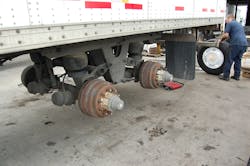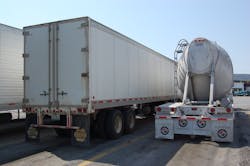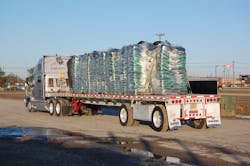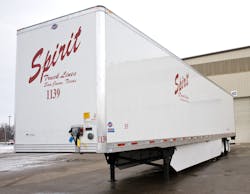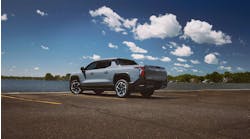There’s probably no greater conundrum for a fleet of any size these days than deciding whether to replace or refurbish equipment—especially as the sticker prices for new trucks and trailers continue to climb. For example, global consulting firm Frost & Sullivan estimated that in 2013 the upfront cost for new equipment climbed 2.7% over 2012. And the price of a new trailer climbed to between $30,000 and $50,000 depending on whether it’s a flatbed, dry van or refrigerated model.
But Craig Bennett, senior vice president-sales & marketing for Utility Trailer Manufacturing Co., believes that the higher initial cost of trailers is leading many trucking operators to try and lengthen ownership cycles.
“The trend a few years ago was towards shorter lifecycles; for example, moving from a seven- to eight-year ownership period for refrigerated units down to five or six years,” explains Bennett. “Now we’re going back the other way towards eight-year and even in some cases 10-year ownership periods. That’s why we’re working to increase the durability of our trailers and extend warranty coverage.”
Bennett adds that he expects the overall trailer market in North America to range between 240,000 and 250,000 units this year, up only a percentage point or two over last year’s numbers. “And 2013 was down a little from 2012,” he points out. “We probably are not going to get back to the 270,000-unit peak we last experienced in 2007.”
Trailer orders of late back up Bennett’s forecast. According to data tracked by ACT Research, manufacturers booked 22,300 net orders in May. “May net orders rose 52% year over year,” notes Frank Maly, ACT’s director of commercial vehicle transportation analysis and research. “Backlog, build, inventory and shipments were all off from April, but the changes were minimal, all less than 1% on a month-over-month basis. This stability provides a solid foundation for the industry as we move into the summer and fall build season.”
Maly adds that trailer production rates should remain relatively unchanged over the next few months, and the order board should continue to support the industry to the next order season this coming fall.
The spike in trailer orders this year doesn’t surprise Jeff Weber, vice president-sales & marketing for Ervin Equipment, as many factors seem to be aligning in favor of replacement versus refurbishment.
“It’s the age-old question for fleet owners: When is it time to trade-in older equipment? That process is subjective and, for the most part, dependent on the distance and frequency of travel, type of materials hauled, and current total cost of ownership,” he explains. “Your bottom line should be the determining factor of whether you upgrade a trailer.”
Weber’s 10-plus years of working on the front lines of trailer sales tell him that the older equipment gets, the more likely it is that maintenance costs will increase. “It’s a fact of life and it’s the reason fleet managers should always have not just a ballpark idea of where a trailer’s residual value sits, but a very specific system for tracking it,” he says. “This way, when maintenance costs begin to climb, they’ll know when they’re approaching their breaking point.”
Weber adds that most equipment owners and fleet managers have at least a rough estimate of what they spend per year on key items such as tires and brakes. However, many fall short when it comes to drilling down to the cost of more unique maintenance items, such as replacing doors or the interior lining of a dry van trailer.
BOTTOM LINE ON TRADING
When you’re at the crossroads, there’s a relatively easy equation to keep in mind,” he points out. “Say the residual value of the trailer is at or near $6,000. If it’s costing $1,500 to $2,000 per year to maintain because of its age, it’s a good time to evaluate what you could get if you were to upgrade. As a general rule of thumb, on equipment more than 10 years old, if repair bills or maintenance expenses exceed 30% to 40% of the trailer’s value, it’s time to trade it in.”
Rodney Ehrlich, senior vice president and chief technology officer for Wabash National Trailers, adds that fleets can also gain greater efficiencies by replacing older trailers with new units, especially when it comes to dry van models.
“New 53-ft. dry van models are 600 to 700 lbs. lighter on average compared to 10 years ago. And in some cases, they are 1,500 lbs. lighter due to new designs,” he says. “Today, most of the dry van market has shifted away from heavier sheet-and-post designs to composite models, which is also allowing fleets to extend lifecycles from eight to 10 years out to 13, 14, and even 15 years.”
Yet Rob Fortney, dealer sales director for Great Dane Trailers, cautions fleets and individual equipment owners alike that proper spec’ing is the most critical factor in determining whether trailers can last upwards of 15 years in service while keeping maintenance costs in line.
“More than any other factor this will determine if the trailer will prove satisfactory now and in the future,” he stressed.
Fortney also notes that in some industries with heavy load requirements, such as for automotive parts and paper, shippers often require the trailer to be below a certain age point in order to protect against accidents and cargo damage due to trailer failure. “In those cases, it’s often more prudent to replace rather than refurbish an older trailer,” he says.
Ervin Equipment’s Weber points out, too, that not only are newer trailer models lighter, the technology within them—specifically the lighting systems and suspension—has improved so much over the past 10 to 15 years that a new trailer often requires very little maintenance within the first 36 months.
“Further, a trailer that is 10 or more years old might no longer suit industry specs,” he stresses. “For example, if the trend is hauling freight that is continuously getting heavier, an older trailer might not be built to handle it. In that case, it’s best to get the best residual value out of your older trailer today and spec a new trailer built for what your business currently requires.”
WHETHER TO REFURBISH
Still, an equipment owner staring down a $50,000 price tag for a new trailer unit might well consider refurbishing an older model to gain a few more years of use. Great Dane’s Fortney says several components will play key roles in the decision to refurbish, including:
- Condition and operation of the doors
- Floor system, including the condition of the top floor
- Condition and structural integrity of the crossmembers
- Connection points between the crossmembers and the bottom trailer rail, including inspecting for corrosion of the rail, the crossmember clip and fastener
- Suspension and undercarriage, including the support gear
- Wheel ends and tire and wheel condition
- Electrical, lighting and air system
When it comes to specific types of trailers, such as refrigerated units and flatbeds, some different calculations are required, he says. “Refurbishing older refrigerated trailers is typically more complicated and costly, so a decision to refurbish reefer units requires careful cost/benefit analysis,” stresses Fortney. “Even if the trailer can be made to look like new, older refrigerated trailers typically lose a considerable amount of thermal integrity as they age and the foam insulation degrades. Older reefers are also subject to air leaks, allowing the cooled air to escape.”
He adds that the emissions restrictions placed on older refrigeration power units by the California Air Resources Board need to be considered as well.
“Older refrigerated trailers also absorb moisture over time and can gain as much as 2,000 to 3,000 lbs. over a 10-year period,” Fortney points out. “The last 10 years have seen tremendous advancements in refrigerated interior linings becoming much stronger and more durable, better in appearance, and lighter in weight. Refrigeration units from both Carrier and Thermo King have also become more efficient in their ability to maintain temperature as well as [improve] fuel economy.”
And when it comes to flatbed trailers, he explains that refurbishing would likely include careful inspection for rust and corrosion and the general integrity of the beams and crossmembers. It would also include repainting steel surfaces and repairing or replacing aluminum parts. “Evaluation of the floor, whether it be all wood or aluminum with wood nailing strips, would be prudent as well,” Fortney says.
If needed, swing doors on the dry van model front are generally easy and inexpensive to replace. “New doors can solve a lot of water leak issues with older trailers,” explains Fortney. “This is also a good time to refurbish and repaint the rear frame and bumper. A general inspection of the suspension system, springs, bushings, alignment settings, etc., is also a good idea. Wheel end maintenance or replacement of the hub, brake drum, wheel seals, bearings and hub cap is a wise investment.”
While the wheel end is off, equipment owners might as well replace the brake shoes. “Wheels should be inspected for cracks, damage or corrosion, with a new set of tires or [retreads] installed as well,” he notes.
Fortney says equipment owners should think about upgrading to LED, or light emitting diode, lighting systems as they engage in trailer refurbishment. “LED replacement lighting has gone down in price in the last several years and could be a reasonable replacement for lower maintenance cost. Also, better visibility [of] LEDs can enhance safety,” he explains.
Wabash’s Ehrlich stresses, too, that LED lighting offers several advantages over older-style incandescent bulbs, primarily because LED electrical power systems aren’t as vulnerable to corrosion.
WHETHER TO BUY NEW
Great Dane’s Fortney says that advances in materials have also helped reduce new trailer costs. “New trailers include the latest in technology in terms of lighter weight structures and components, aerodynamic enhancements, cargo restraint, and corrosion resistance,” he explains. “They are less likely to need repairs than used trailers, which typically take the trailer out of productive service. ”
A solid preventive maintenance (PM) program is a must for trailers, says Fortney. Good PM practices help ensure that equipment owners will maximize their trailer’s value regardless of their make, model and specs, he emphasizes.
“A general inspection of the equipment every 60 days, depending on usage, is the key to reduced trailer downtime, cargo damage, etc.,” Fortney says. “Inspect for damage that could cause problems related to water leaks, cargo damage, and structural integrity. Inspect the roof, the nose rail, the lining material, the scuff band, the rear door seals, and hardware.”
He adds that PM attention needs to be paid to tire condition and tire air pressure, wheel condition, wheel ends, brake condition (both shoe and drum), and brake adjustment. Attention to the condition and operation of the air system including gladhands and seals, brake valves, antilock braking system, brake chambers, and slacks and cams is also crucial.
“Inspect and ensure all the lights are properly located and secured. Inspect and repair as necessary the electrical harness to ensure it is properly secured,” he stresses. “Proper repairs to body damage versus a patch are generally a wise investment as proper repairs ensure not only the structural integrity of the trailer but are also much less likely to leak than a silicone patch.”
As the experts note, the decision on whether to refurbish an existing trailer or purchase a new one goes beyond simply cost. And there are plenty of steps to take to extend a trailer’s useful life if the choice is refurbishment. Regardless of the choice, though, a proper cost-benefit analysis must be done before making an ultimate decision.
IMPROVING FUEL ECONOMY ONE BOX AT A TIME
Making trailers more fuel-efficient is not an easy task due to their largely non-aerodynamic shape and because they don’t burn fuel “directly” the way an over-the-road tractor does.
Still, more attention is being paid to the impact trailers have on fuel economy. Design and regulatory efforts are underway to develop trailers that are more “fuel-burn friendly.”
“While the trailer doesn’t actually burn any fuel—refrigerated trailers excluded—it does have a huge impact on the amount of fuel the connected tractor burns,” explains Rob Fortney, dealer sales director for Great Dane Trailers.
Numerous aerodynamic accessories can be added to new and old trailers, he points out, with such devices including aerodynamic side skirts, trailer tails, under-tray systems, nose cone or gap-reducing front wall devices, and wheel fillers.
“When the California Air Resources Board trailer fuel-efficiency requirement was enacted, many fleets and owner-operators grumbled about the cost plus the potential impact on durability, trailer appearance, etc.,” he says.
“Over the last several years, though, the fuel-saving benefits of these devices have proven to be durable and effective in reducing tractor fuel consumption,” Fortney continues. “A combination of devices returned as much as 10% fuel savings to some fleets.”
Jeff Weber, vice president-sales & marketing for Ervin Equipment, stresses that not much more can be done in the trailer industry to increase fuel efficiency. “We’ve installed aerodynamic devices and automatic tire inflation systems, and manufacturers are making the lightest trailers they’ve ever made.
“Aside from a driver’s habits, there aren’t a lot more changes from the trailer side that will help boost fuel efficiency,” he points out. “If you are weight-conscious and hauling an older, heavier trailer, buying a new trailer is a good fuel-economy solution as well.”

